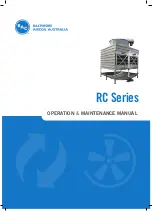
FORM 160.77-O1
ISSUE DATE: 10/22/2020
JOHNSON CONTROLS
22
SECTION 3 - MAINTENANCE
CONDUCTING AN R-22 PRESSURE TEST
With the R-134a charge removed and all known leaks
repaired, the system should be charged with a small
amount of R-22 mixed with dry nitrogen so that a ha-
lide torch or electronic leak detector can be used to de-
tect any leaks too small to be found by the soap test.
To test with R-22, proceed as follows:
1. With no pressure in the system, charge R-22 gas
into the system through the charging valve to a
pressure of 2 PSIG (14 kPa).
2. Build up the system pressure with dry nitrogen to
approximately 75 to 100 PSIG (517 to 690 kPa).
To be sure that the concentration of refrigerant has
reached all parts of the system test for the pres-
ence of refrigerant with a leak detector at an ap-
propriate service valve.
3. Test around each joint and factory weld. It is im-
portant that this test be thoroughly and carefully
done, spending as much time as necessary and us-
ing a good leak detector.
4. To check for refrigerant leaks in the evaporator
and condenser, open the vents in the evaporator
and condenser heads and test for the presence of
refrigerant. If no refrigerant is present, the tubes
and tube sheets may be considered tight. If refrig-
erant is detected at the vents, the heads must be
removed, the leak located (by means of soap test
or leak detector) and repaired.
LD00949
FIGURE 10 -
EVACUATION OF CHILLER













































